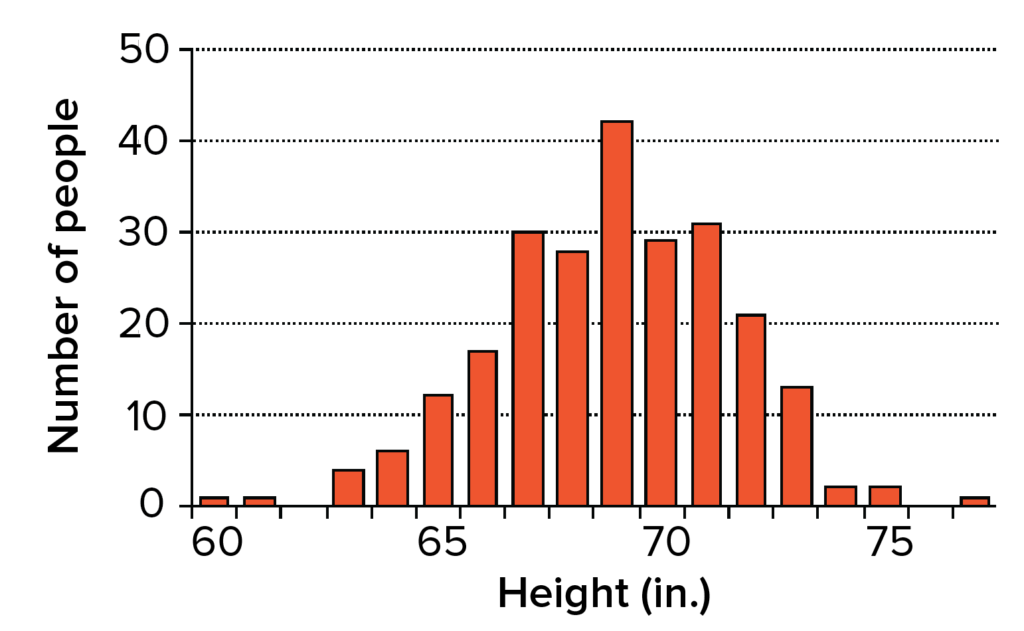Learning Outcomes
- Describe polygenic inheritance and how to recognize it
- Describe continuous variation and how to recognize it
How is Height Inherited?
Many heritable human characteristics don’t seem to follow Mendelian rules in their inheritance patterns. For example, consider human height. Unlike a simple Mendelian characteristic, human height displays:
- Continuous variation. Unlike Mendel’s pea plants, humans don’t come in two clear-cut “tall” and “short” varieties. In fact, they don’t even come in four heights, or eight, or sixteen. Instead, it’s possible to get humans of many different heights, and height can vary in increments of inches or fractions of inches. As an example, consider the bell curve-shaped graph in Figure 1, which shows the heights of a group of male high school seniors.
- A complex inheritance pattern. If you’ve paid attention to the heights of your friends and family, you may have noticed that many different patterns of inheritance are possible. Tall parents can have a short child, short parents can have a tall child, and two parents of different heights may or may not have a child of intermediate height. In addition, siblings with the same two parents may have a range of heights, ones that don’t fall into clear, distinct categories. Simple models involving one or two genes can’t accurately predict all of these inheritance patterns.

Figure 1. Heights of male high school seniors. Image modified from “Continuous variation: Quantitative traits,” by J. W. Kimball (CC BY 3.0).
Some human characteristics, such as height, eye color, and hair color, don’t come in just a few distinct forms. Instead, they vary in small gradations, forming a spectrum or continuum of possible phenotypes.
How, then, is height inherited? Height and other similar features are controlled not just by one gene, but rather, by multiple (often many) genes that each make a small contribution to the overall outcome. This inheritance pattern is called polygenic inheritance (poly– = many). For instance, a recent study found over 400 genes linked to variation in height[1]. When there are large numbers of genes involved, it becomes hard to distinguish the effect of each individual gene, and even harder to see that gene variants (alleles) are inherited according to Mendelian rules. In a further complication, height doesn’t just depend on genetics: it also depends a lot on environmental factors, such as a child’s overall health and the type of nutrition they receive while growing up.
PRactice Questions
We’ve learned about polygenic inheritance and continuous variation. Just what is the difference between these two types of inheritance?
Try It
Candela Citations
- Polygenic inheritance and environmental effects. Provided by: Khan Academy. Located at: https://www.khanacademy.org/science/biology/classical-genetics/variations-on-mendelian-genetics/a/polygenic-inheritance-and-environmental-effects. License: CC BY-NC-SA: Attribution-NonCommercial-ShareAlike
- Wood, A. R., Esko, T., Yang, J., Vedantam, S., Pers, T. H., Gustafsson, S., ... Frayling, T. M. (2014). Defining the role of common variation in the genomic and biological architecture of adult human height. Nature Genetics, 46, 1173–1186. http://dx.doi.org/10.1038/ng.3097. ↵
